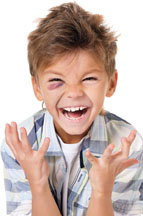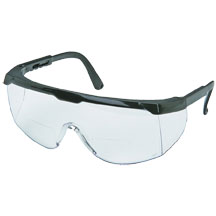Quiz – A Good Eye For Safety

Many people today are concerned about eye strain, and their worries are valid as computer use is now a major part of our daily lives. But in thinking about eye safety, we musn’t forget about the good ol’ fashioned poke in the eye that, unfortunately, can occur in the home, at work, or at play. The good news is that many of these common eye injuries can be prevented. Take our quiz to learn more:
1. Eye injuries affect an estimated 2.5 million people every year.
A. True
B. False

2. A common cause of eye injuries in children is:
A. Misuse of toys
B. Falls from beds or against furniture
C. Misuse of everyday tools and objects (tools, silverware, pens and pencils)
D. Contact with harmful household products (detergents, paints, glues, etc.)
E. All of the above
3. When a speck or foreign particle enters your eye, first try to:
A. Let tears wash the speck out, or use an eyewash if you have one
B. Pull the upper lid down onto lower lid and let lower eyelashes sweep away the particle by blinking repeatedly.
C. Both A and B
D. Rub your eye gently to dislodge the speck.
4. If the coach of your child’s sports team doesn’t insist that safety eyewear is necessary, it’s a safe bet that it isn’t an issue.
A. True
B. False
5. When applying first aid for cuts in or around the eye, DO NOT:
A. Rub, rinse, or apply pressure to the eye.
B. Try to remove particles
C. Take aspirin, ibuprofen, or other nonsteroid anti-inflammatories
D. All of the above

Answers:
1. A. True. Thousands of eye accidents happen every day and most of them are preventable with the use of safety eyewear.
2. E. All of the above. Other common causes outside the home are automobile accidents and sports injuries.
3. C. Both A and B are safe ways to try removing a small foreign particle. Do not rub your eye.
4. B. False. Don’t assume—parents should meet with a child’s coach to make sure they are aware of the injury risks associated with their particular sport and that proper procedures are in place to handle such an injury. Parents should also set an example by using appropriate eyewear when they play sports.
5. D. All of the above. Instead, bandage the eye gently and seek medical attention. The drugs mentioned above are to be avoided because they may increase bleeding.
Source: The Health Library, with additional information provided by Prevent Blindness America.